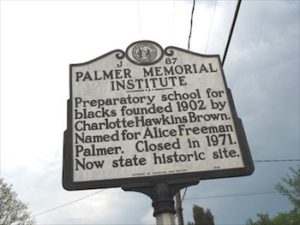
*On this date in 1902, we celebrate the Alice Freeman Palmer Memorial Institute. Also known as Palmer Memorial Institute, it was an American school for upper-class Blacks.
Dr. Charlotte Hawkins Brown founded it in Sedalia, North Carolina, near Greensboro. Palmer Memorial Institute was named after Alice Freeman Palmer, former president of Wellesley College and benefactor of Dr. Brown, who died on this date. More than 1,000 African American students attended the school between 1902 and 1970. It became a fully accredited, nationally recognized preparatory school before its closure in the 1970s. Bennett College purchased the Palmer campus, but in 1980, it sold 40 acres (160,000 m2) of the main campus with significant surviving buildings to the American Muslim Mission. The Muslims who belong to the community that followed Imam Wallace D. Mohammed tried to establish a teacher's college but abandoned this project due to the bad condition of the campus.
In late 1982, Maria Cole, a niece of Dr. Brown's and widow of late singer Nat King Cole and friend Marie Gibbs of Greensboro, began an effort to obtain recognition of Dr. Brown's social and educational contributions, specifically regarding Palmer Memorial Institute. Both women, former Palmer Memorial Institute students, sponsored Palmer alum meetings and enlisted support for this cause. They also met with North Carolina's Division of Archives and History to explore ideas. Through the assistance of North Carolina Senator Bill Martin, a special bill was passed in the 1983 General Assembly that allowed for planning by Archives and History of the state's first African American state historic site as a memorial to Dr. Brown. In November 1987, the memorial officially opened as a state historic site.
The Palmer Memorial Institute Historic District was listed on the National Register of Historic Places in 1988. The district encompasses 16 contributing buildings, two contributing sites, three contributing structures, and two contributing objects. They include the Queen Anne style Galen Stone Hall designed by Harry Barton (1876-1937), Charles W. Eliot Hall, and Kimball Hall; Alice Freeman Palmer Building (1922); Congregational Women's Cottage and Carrie M. Stone Cottage designed by Charles C. Hartmann; Rev. John Brice House (c. 1926); Bethany United Church of Christ (1870, c. 1925, c. 1975); and Robert B. Andrew Farm and Store/Post Office.
The restored campus buildings of the Palmer Memorial Institute are now the Charlotte Hawkins Brown Museum, which belongs to the North Carolina Department of Natural and Cultural Resources. The museum links Dr. Brown and Palmer Memorial Institute to the larger themes of African American women, education, and social history, with an emphasis on the contributions made by African American citizens to education in North Carolina.
The museum's visitor center is in the Carrie M. Stone Teachers' Cottage (1948) and features exhibits about Dr. Brown, the Institute, and African American education in North Carolina. There is also a video about the school. Visitors can tour Dr. Brown's residence, known as Canary Cottage, which has been furnished to reflect the 1940s and 1950s when the school was at its peak. Several dormitories, the dining hall, the bell tower, the teahouse, and teachers' cottages can also be seen. In 1994, the Historic Sites Section completed comprehensive Brown and the Palmer Institute research and restored or stabilized several other structures.